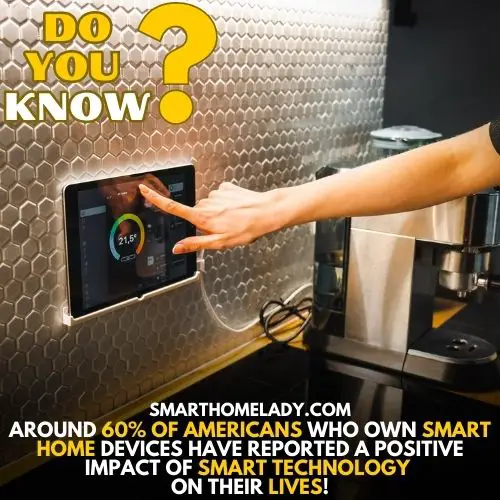Here are a few fascinating Smart home Statistics, facts, and data that reveal the growing trends and impact of smart home technology on our daily lives.
Let’s explore the numbers that shed light on the rise of connected homes and the increasing adoption of smart devices in modern households.
25 Key Smart Home Statistics
- As per Oberlo, the global market is expected to witness an impressive number of 77.05 million Smart Homes by the year 2025.
- It is estimated that there will be 68.6% active smart home device users in the United States, marking a 56.6% increase compared to 2022.
- American owners of smart home devices spent an average of $1,172 on their smart-tech household electronics.
- Around 60% of Americans who own smart home devices have reported a positive impact of smart technology on their lives.
- Approximately 300 million smart homes are estimated to exist worldwide.

- The smart home industry automation in U.S. households is projected to surpass 53.9% by the year 2025.
- Experts predict that the global home automation market will exceed $81.6 billion by the year 2025.
- Among Americans concerned with climate change, 59% are willing to pay a premium for smart home devices.
- Despite 75% of individuals expressing a degree of distrust regarding data usage, the majority are still open to embracing smart home technology.
- A significant 74% of smart home users in the United States believe that certain smart home devices are not essential.
- The US smart home market is poised for continuous expansion, with projected annual growth rates of 10.2% anticipated between 2024 and 2027.
- Smart home adoption varies between genders in the United States, with 82% of men and 49% of women owning at least one smart home device.
- Among the range of smart home devices available for kitchen automation, smart fridges reign supreme, being owned by 4.7% of US consumers, making them the most popular choice.
- Additionally, 4.1% of US consumers possess smart microwaves, 3.4% own smart coffee makers, and 3.3% have smart kitchen scales.
- Among US consumers, 2.5% own smart faucets, while 2.3% possess smart pet feeders.
- 2.2% have smart cooking thermometers, and the same percentage (2.1%) also own smart ice machines, air fryers, and herb gardens.
- Smart washers are the most prevalent smart home devices for bathroom and laundry applications, with 5.2% of Americans owning one.
- Fitness scales take the lead as the most popular smart home devices for fitness and health, being owned by 5.2% of US consumers.
- A notable 20% of US consumers express their desire for voice assistant capabilities in their lighting systems.
- Around 40% of individuals believe that smart home technology contributes to an overall enhanced living experience. Additionally, 39% consider the ease of voice activation alone as a compelling reason to invest in such technology.
- A significant 38% of American consumers opt for smart home devices primarily due to their superior convenience compared to traditional electronics.
- Smartphones lead the pack as the most popular smart home device, with a remarkable 85% ownership among American consumers.
- Among the smart home devices designed for personal use, smart headphones hold the second spot, with 32.5% of Americans stating that they own a pair.
- Additionally, 26% of US consumers possess smartwatches, while 23.5% have tablets equipped with voice control capabilities.
- It is noteworthy that 20% of American households have installed 7 or more smart home devices, demonstrating a growing trend in home automation adoption.
Statistics On the Internet & Connectivity Of Smart Homes
- Based on the latest trends in smart home consumer behavior, Americans have shown a substantial increase in data usage on their iPhone 12s. In 2022, the average data spent per month witnessed a remarkable surge of 103.8%, rising from 4.03 GB in 2021 to 8.21 GB.
- Moreover, data consumption with Amazon Fire TV 3s has doubled in the current year, surging from 6.18 GBs to 12.36 GBs.
- As per recent findings, approximately 22% of emerging smart home startups have placed a strong emphasis on enhancing connectivity for their products.
Statistics About Privacy & Vulnerability Of Smart Homes
- Alarmingly, 40.8% of smart homes currently possess at least one vulnerable device that is susceptible to cyberattacks.
- More than 40% of smart home devices are reported to have vulnerabilities, with a significant 69.2% of these vulnerabilities attributed to weak credentials.
- Routers stand out as the most susceptible to weak credentials, with approximately 59.7% of routers worldwide exhibiting some form of vulnerability.
- Furthermore, a concerning 59.1% of global users have not taken the essential step of logging into their routers or updating their firmware, leaving their devices exposed to potential security risks.
- For smart outdoor devices, 3.4% of Americans have adopted smart sprinkler control systems, while 2.6% have integrated outdoor lighting systems to enhance their homes.
- Additionally, approximately 1.6% of consumers in the United States of America have chosen to integrate smart padlocks and smart mailboxes in their homes for added convenience and security.
Statistics of Smart Home By Device
9 Statistics For Smart Home Security
- In 2022, the revenue generated by the global smart home security market amounted to an impressive $3.27 billion. Experts predict that this figure will soar even higher and surpass $5 billion by the year 2025.
- Homeowners can reap significant benefits from smart security systems, as they have the potential to reduce home insurance rates by 20%.
- The revenue projections for the global smart doorbell market have witnessed a remarkable increase, reaching an estimated $13 billion.
- Among safety and security smart home devices, video doorbells hold the top spot, with approximately 14.6% of Americans owning them, indicating their popularity among consumers.

- Apart from video doorbells, a considerable 12.3% of Americans have opted to support their home security with outdoor security cameras, while 9.3% have made the choice to install indoor security cameras for added protection.
- Additionally, 8.9% of households have embraced the convenience and security provided by motion detectors, while 8.2% have adopted smart door locks to enhance their access control.
- Smart smoke detectors have also acquired significant interest, with 7.6% of US consumers investing in these innovative devices to ensure early detection and safety from potential fire hazards.
- Notably, 7.2% of homeowners have taken the precaution of owning smart door or window sensors to reinforce their security measures, while 4.8% have integrated interactive security hubs to centralize and manage their smart home systems effectively.
- Moreover, there is a growing awareness of indoor air quality, with 4.6% of US consumers investing in air quality monitors to ensure a healthier living environment.
Statistics On Smart Home Lights
- In 2022, smart lighting was expected to be adopted in 6.6% of households, with a projected increase to 21.5% by 2027.
- About 15% of an average home’s electricity consumption is attributed to lighting. By using LED lighting, households can save approximately $225 annually.
- The smart lighting market is estimated to grow almost fourfold, reaching $44 billion by 2030 from $11 billion in 2020.
Statistics For Heating & Cooling System Of Smart Homes
- According to data, Energy Star-certified smart thermostats can reduce heating time in homes by a minimum of 8% and cooling time by 10% or more.
- Experts predict that the market for smart thermostats will exceed $8 billion by 2026.
- By the end of 2022, approximately 19.6 million smart thermostats were reportedly installed in the United States.
- It is estimated that if every home with an HVAC system had a smart thermostat by 2026, it could potentially decrease annual energy consumption for heating and cooling by 9%.
Smart TV Statistics
- Smart TVs and speaker systems have emerged as the leading choices among the various types of smart home technology integrated into households.
- Home automation system statistics reveal that 44% of smart homes feature smart entertainment systems, including popular devices like Google Chromecast, Apple TV, or Amazon FireTV, showcasing the growing interest in smart entertainment solutions.
- In 2020, the global demand for smart TVs was measured at an impressive 268.9 million units. Industry experts project this market to maintain a robust growth trajectory, with a compounded annual growth rate (CAGR) of 20.8% from 2021 to 2028, indicating a continuous surge in demand for these cutting-edge entertainment devices.
Statistics About Smart Appliances
- Smart appliances hold a dominant position in generating the most substantial share of the overall market income, with global consumers projected to spend an impressive $21.5 billion in 2023.
- The global smart kitchen market is expected to witness continuous growth through 2027, reaching a substantial value of $43 billion, signifying the increasing interest and adoption of smart kitchen technologies.
- One of the notable advantages of smart refrigerators is their remarkable contribution to energy efficiency. Compared to earlier models, which consumed up to 1,278 kWh per year, smart refrigerators offer an average capacity of more than 21.9%, presenting a significant reduction in energy consumption.
4 Statistics On Smart Home Voice Assistants
- Forecasts indicate a remarkable surge in digital voice assistant adoption, with an estimated 8.4 billion units expected by 2024, exceeding the global population figure.
- Around 34% of U.S. citizens actively utilize the search-by-voice feature at least once per month, showcasing the growing preference for voice-based interactions in daily tasks.
- The total worldwide transaction value of purchases made through voice assistants on smart-home devices is anticipated to experience a significant increase, soaring from $22 billion in 2020 to a substantial $164 billion by 2025, reflecting the increasing trust and convenience consumers find in voice-driven shopping experiences.
- The market size for voice assistants is set for remarkable growth, and experts anticipate it to reach $99 billion by 2026, underlining the potential for further growth and innovation in the voice technology industry.
4 Smart Home Effects On Real Estate
- Millennials are significantly impacting the real estate landscape as they prioritize the connectivity of smart homes, displaying a willingness to pay 20% or more for these advanced features in home upgrades.
- A substantial 81% of consumers express a higher likelihood of purchasing a new home that incorporates smart technology, underlining the growing demand and appeal of smart home solutions in the housing market.
- For Gen Z renters, smart home technology holds substantial importance, with 62% stating it is a crucial factor in deciding where they choose to live, indicating the increasing significance of such amenities for the younger generation.
- In 2019, 43% of Gen Z homebuyers emphasized the importance of smart home capabilities, while only 15% of Baby Boomers shared the same sentiment, highlighting the generational differences in the prioritization of smart home features in the home buying process.
Sources
- Smart Home Statistics By Oberlo (Source Link)
- Smart Home Future – What Will Smart Homes Look Like 10 Years From Now? (Source Link)
- Smart Home Stats By Exploding Topics (Source Link)
- Smart home in the United States – statistics & facts By Statista (Source Link)
- Smart kitchen market revenue worldwide from 2017 to 2027, by Statista (Source Link)
- Incredible Smart Home Statistics By Bankless Time (Source Link)

